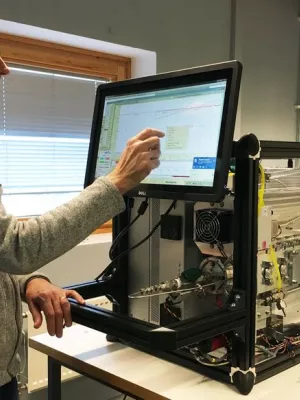
Erik Swietlicki
Professor

Properties and toxicological effects of particles from the interaction between tyres, road pavement and winter traction material
Author
Summary, in English
In regions where studded tyres and traction material are used during winter, e.g. the Nordic countries, northern part of USA, Canada, and Japan, mechanically generated particles from traffic are the main reason for high particle mass concentrations in busy street and road environments. In many Nordic municipalities the European environmental quality standard for inhalable particles (PM(10)) is exceeded due to these particles. In this study, particles from the wear of studded and studless friction tyres on two pavements and traction sanding were generated using a road simulator. The particles were characterized using particle sizers, Particle Induced X-Ray Emission Analysis and electron microscopy. Cell studies were conducted on particles sampled from the tests with studded tyres and compared with street environment, diesel exhaust and subway PM(10), respectively. The results show that in the road simulator, where resuspension is minimized, studded tyres produce tens of times more particles than friction tyres. Chemical analysis of the sampled particles shows that the generated wear particles consist almost entirely of minerals from the pavement stone material, but also that Sulfur is enriched for the submicron particles and that Zink is enriched for friction tyres for all particles sizes. The chemical data can be used for source identification and apportionment in urban aerosol studies. A mode of ultra-fine particles was also present and is hypothesised to originate in the tyres. Further, traction material properties affect PM(10) emission. The inflammatory potential of the particles from wear of pavements seems to depend on type of pavement and can be at least as potent as diesel exhaust particles. The results imply that there is a need and a good potential to reduce particle emission from pavement wear and winter time road and street operation by adjusting both studded tyre use as well as pavement and traction material properties.
Department/s
- Ergonomics and Aerosol Technology
Publishing year
2008
Language
English
Pages
226-240
Publication/Series
Science of the Total Environment
Volume
393
Issue
2-3
Links
- Publication in Lund University research portal
- http://www.sciencedirect.com/science?_ob=ArticleURL&_udi=B6V78-4RS9SJX-2&_user=745831&_rdoc=1&_fmt=&_orig=search&_sort=d&view=c&_acct=C000041498&_version=1&_urlVersion=0&_userid=745831&md5=41dd179869def66a74cce51d3108ae15
- http://dx.doi.org/10.1016/j.scitotenv.2007.12.030
Document type
Journal article
Publisher
Elsevier
Topic
- Environmental Sciences
Status
Published
ISBN/ISSN/Other
- ISSN: 1879-1026